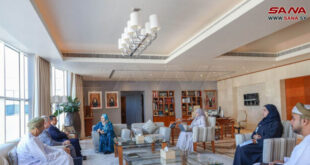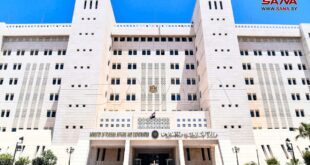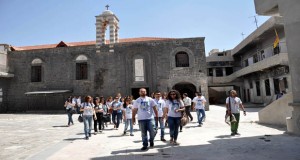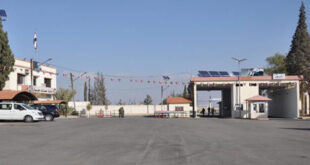Homs, SANA After restoring security and stability to the majority of the neighborhoods of the city of Homs and the halt of the students’ activities for more than four years due to the heinous war waged against Syria, a number of
students of the Faculty of Tourism organized a scientific tour to a number of neighborhoods in the old city of Homs.
The tour included many ancient archeological sites in the old city which were demolished and sabotaged by the terrorist organizations, mainly al-Zahrawi Palace.
Al-Zahrawi Palace (Qasr al-Zahrawi) is one of the most beautiful historic houses in Homs, located in the old city neighborhood of al-Hamidiyeh. This two story building features a delightful courtyard with a central fountain and a
large iwan on the southern side. It was constructed primarily of black basaltic stone, with some limestone used around the windows and doorways for decoration. The upper floors feature numerous arched loggias overlooking the central courtyard.
The present day structure dates mostly from the Ottoman era, though some portions of Qasr al -Zahrawi date back to the Mamluk period and earlier. The Directorate General for Antiquities and Museums (DGAM) recently restored Qasr al-Zahrawi with the intention of opening it to the public as a museum of Folk Culture and Traditions.
The building suffered significant damage during 2012-2014 of the war waged against the country, however, and will be in need of substantial repairs in the coming years.
The students also toured a number of churches which were sabotaged and destroyed by the terrorists, among them the saint Mary of the Holy Belt Church and al-Arba’in Church, dating back to 1920.
Saint Mary Church of the Holy Belt (Um az-Zinnar) is a historical Syriac Orthodox Church in Homs. The church is built over an underground church dating back to 50 AD. It is the seat of the Syriac Orthodox archbishopric. The church contains a venerated relic that is supposed to be a section of the belt of Mary mother of Jesus.
The church was damaged at the hands of the armed terrorist groups in 2011-2012, as the terrorists used it as a shield .
The students’ tour was concluded by visiting al- Bustan restaurant in Homs which was restored following restoring security and stability to the city.
The tour is a message emphasizing continued safety and stability in the city, Homs governor Talal al-Barazi said,adding that the presence of the students in the archeological and tourist sites enhances the concept of linking the
local community with al-Baath University to achieve the scientific and vocational benefits for
the students and the society.
Al-Barazi pointed out that upon the directives of president Bashar al-Assad, the studies of rehabilitating and restoring a number of archeological and historical sites in the old city were outlined.
He asserted that life start to return to the neighborhoods of the old city as many of the displaced people started to return to their homes after ensuring main services in the neighborhoods.
The students told SANA that the tour, which included scores of tourist and archeological milestones, aimed at getting acquainted with the reality of the neighborhoods in the old city and contribute to encouraging internal tourism
among the Syrian cities.
The Faculty of Tourism, al-Baath University includes 900 students in regular education and
2300 others in the open-learning education. The faculty offered a number of tourist cadres.
H. Zain/ Barry
 Syrian Arab News Agency S A N A
Syrian Arab News Agency S A N A







